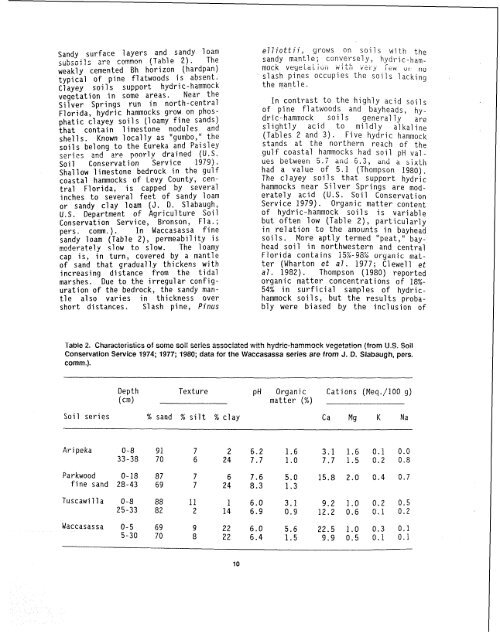The Ecology of Hydric Hammocks - USGS National Wetlands ...
The Ecology of Hydric Hammocks - USGS National Wetlands ...
The Ecology of Hydric Hammocks - USGS National Wetlands ...
You also want an ePaper? Increase the reach of your titles
YUMPU automatically turns print PDFs into web optimized ePapers that Google loves.
Sandy surface layers and sandy loamsubsoils arc com~on (Table 2). <strong>The</strong>weakly cemented Bh horizon (hardpan)typical <strong>of</strong> pine flatwoods is absent.Clayey soi 1 s support hydric-hammockvegetation in some areas. Near theSilver Springs run in north-centralFlorida, hydric hammocks grow on phosphaticclayey soils (loamy fine sands)that contain 1 imestone nodules andshells. Known locally as "gumbo," thesoils belong to the Eureka and Paisleyseries and are poorly drained (U.S.Soil Conservation Service 1979).Shallow limestone bedrock in the gulfcoastal hammocks <strong>of</strong> Levy County, centralFlorida, is capped by severalinches to several feet <strong>of</strong> sandy loamor sandy clay loam (J. D. Slabaugh,U.S. Department <strong>of</strong> Agriculture SoilConservation Service, Bronson, Fl a. ;pers. comm.). In Waccasassa finesandy loam (Table 2), permeabil ity ismoderately slow t.o slow. <strong>The</strong> loamycap is, in turn, covered by a mantle<strong>of</strong> sand that gradually thickens withincreasing distance from the tidalmarshes. Due to the irregular configuration<strong>of</strong> the bedrock, the sandy mantlealso varies in thickness overshort distances. Slash pine, Pinuse]]iottii, grows On soils with thesandy mantle; conversely, hydric-hammockveyeial iurr w;~:I ve1-y ;CW VT ftOslash pines occupies the soils lackingthe mantle.In contrast to the highly acid soils<strong>of</strong> pine flatwoods and bayheads, hydric-hammocksoils generally areslightly acid to mildly alkaline(Tables 2 and 3). Five hydric hammockstands at the northern reach <strong>of</strong> thegulf coastal hammocks had soil pH valuesbetween 5.7 dtid 5.3, end 5 ixthhad a value <strong>of</strong> 5.1 (Thompson 1980).<strong>The</strong> clayey soi 1 s that support hydrichammocks near Silver Springs are moderatelyacid (U.S. Soil ConservationService 1979). Organic matter content<strong>of</strong> hydric-hammock soils is variablebut <strong>of</strong>ten low (Table 2), particularlyin relation to the amounts in bayheadsoils. More aptly termed "peat," bayheadsoil in northwestern and centralFlorida contains l5%-98% organic matter(Wharton et al. 1977; Clewell eta 1 . 1982). Thompson (1980) reportedorganic matter concentrations <strong>of</strong> 18%-54% in surficial samples <strong>of</strong> hydrichammocksoils, but the results probablywere biased by the inclusion <strong>of</strong>Table 2. Characteristics <strong>of</strong> some sol1 series associated with hydric-hammock vegetation (from U.S. SoilConservation Service 1974; 1977; 1980; data for the Waccasassa series are from J. D. Slabaugh, pers.comrn.).Depth Texture pH Organic Cations (Meq./100 g)(cm) matter (%)Soil series % sand % silt % clay Ca Mg K NaAripeka 0-8 91 7 2 6.2 1.6 3.1 1.6 0.1 0.033-38 70 6 24 7.7 1 .O 7.7 1.5 0.2 0.8Pa rkwood 0-18 87 7 6 7.6 5.0 15.8 2.0 0.4 0.7fine sand 28-43 69 7 24 8.3 1.3Tuscawi 11 a 0-8 88 11 1 6.0 3.1 9.2 1.0 0.2 0.525-33 82 2 14 6.9 0.9 12.2 0.6 0.1 0.2

















